Failure to move from a feudal monarchy to an inclusive society with equal opportunities for all in a federal State structure will result in anarchy and lead to Nepal's Maoists taking up arms again, says Brigadier (retd) S K Chatterji.
A decade of bush war waged by Maoist guerrillas, followed by a peace treaty and finally an election in 2008 leading to a constituent assembly being established with the mandate to write a new constitution; has been the story of Nepal so far. The man on the street was looking forward to Nepal's reincarnation from a feudal monarchy to an inclusive society with equal opportunities for all in a federal State structure. However, the CA members belied the hopes of Nepalese citizens.
The ministry continues as a caretaker establishment till such time as elections are held again in November 2012 to elect another CA. The road ahead for the next CA will be equally tricky.
The dissolved CA had to contend with a host of contentious issues, the two most difficult being the Maoist precondition of inducting the guerrilla cadres in the Nepal Army and division of Nepal into provinces based on ethnic, lingual, cultural, communal and geographic basis. Of the two, the first one has been resolved, while the other issue has eluded resolution.
The next CA producing the draft constitution is the best option; however, there is a requirement to rethink the methodology should it fail. With the elections now scheduled, political parties must make their stance clear and refrain from promising impossible solutions.
The states to be created, while being acceptable to the Nepalese people, have also to be administratively viable. Too many states will render them unviable, while too few will not satisfy the major ethnic groups. Providing for a contiguous Madhesh for the most populous ethnic group -- Madhesis -- to include all 20 districts of the Terai region along the Nepal-India border, is a strident demand. But Nepalese politicians are wary; it may sow the seeds of Nepal's disintegration. The CA has to ensure a federal structure that does not lead to powerful overarching provincial identities that subject Nepal's cohesion as one nation to undue stresses.
Also casting a shadow is the perception of the long-privileged classes who foresee a loss of influence and income as an inclusive society is ushered in. Till now it was only a few groups that populate the ranks of judiciary, administration and the army. Correcting the imbalance will undoubtedly be at the cost of those who are privileged in Nepal, today.
Hopefully Nepal's political parties in the next CA will make compromises and adjustments as is normal in a democratic culture. However, should the new CA not be able deliver a result, one option is to opt for a national referendum. Before opting for a referendum, other differences in arriving at a constitution need to be resolved in the CA. Options for federal architecture of provinces will also need to be pruned down to two or three to provide clarity to Nepal's voters in exercising choice.
The results of the referendum will have to be binding on all political parties. It would also have to be ensured that the parties do not renew confrontation by reinventing new issues. The validity of the process under Nepalese laws will also need to be confirmed by the Nepalese Supreme Court.
The Indian Constitution provides some cues. Starting with 14 states, the country has 28 now. The dissolved Nepalese CA witnessed far more efforts by the political parties to garner power rather than constitution-writing. A repeat, will neither give succour to Nepalese people, nor ally apprehensions of a breakaway Maoist group opting for arms again.







 © 2025
© 2025